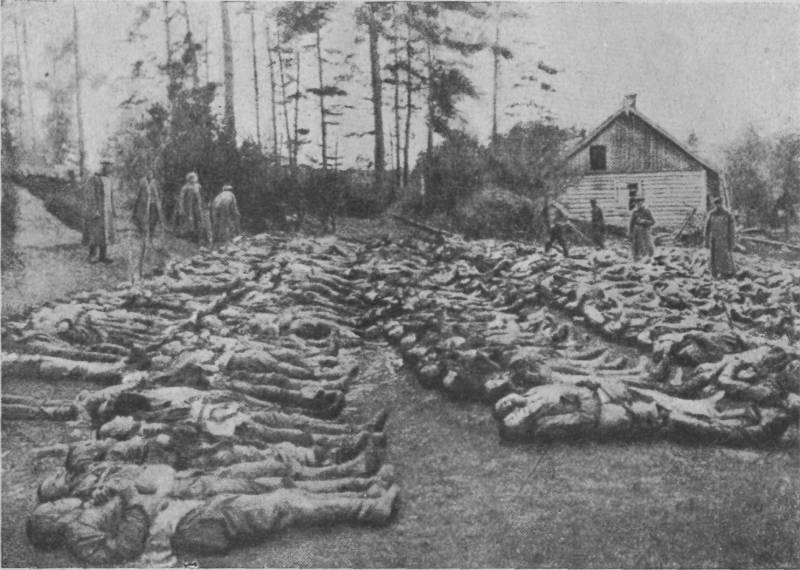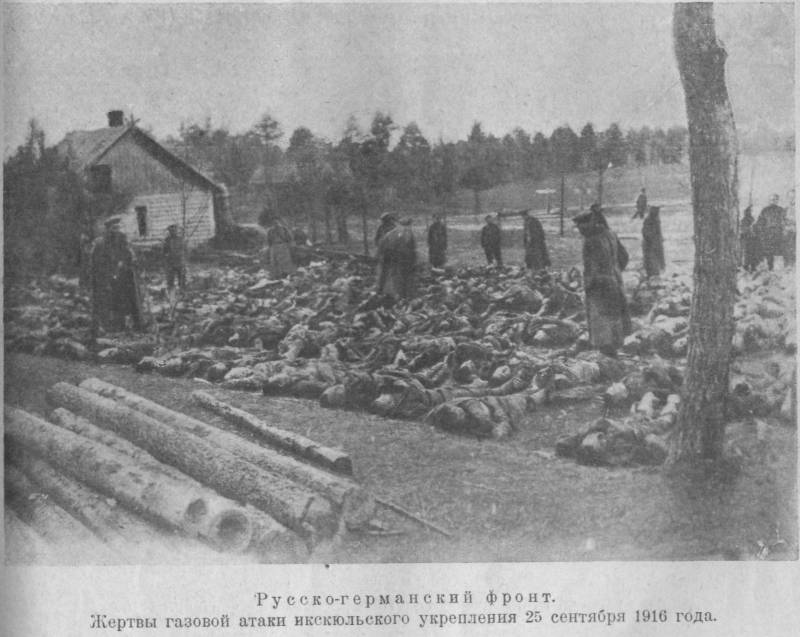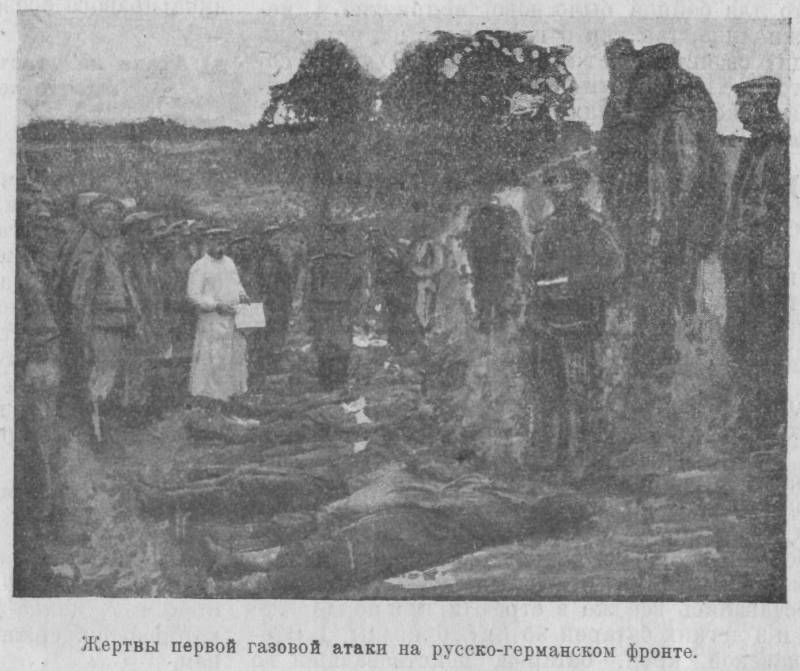In the clubs of a poisonous nightmare. "Gases went to our trenches like thick fog"
Dire consequences
survey protocol consultant Red Cross Society of Medicine of the Russian armies at the North-Western Front Professor MD DM Lavrov on June 29 1915 year contained the following lines: "this was sent to Terezin, where, according to information received by the Medical 18 May 1915 years in part, poisoned officers were delivered in large quantities. The poisoning was made by the enemy, who threw a huge amount of poisonous gas (which turned out to be chlorine) on our advanced trenches on the night of 18. In Terezín, those hours poisoned from 4 hours of the morning to 5 hours of the day 18 May were taken around 400 people, of which the dead were 21 people. Approximately 30% poisoned were in serious condition.
Around 7 hours of the evening there were already 27 corpses, of which one was subjected to anatomical dissection. At 11 hours of the evening I began to inspect the Elizabethan Mobile No. 3 of the infirmary in Ruzov. All the rooms of the infirmary were filled with poisoned ones, of which around 30% were in serious condition. This hospital to 12 hours of night received about 1200 people poisoned; The dead men were located near 140. I drove from Ruzov to Zyrardovo in order to collect information about poisoned people who had entered the designated place. The evacuation point Girardovo received up to 4 hours of the morning around 3000 poisoned, of which approximately 25% were in a state of severe poisoning. Until one o'clock in the afternoon, 19 May item took about 4000 poisoned. I had to go to Staro-Radzivillov, the dressing and nutritional point of which received poisoned 1900, of which 135 - 140 people have already died.
Thus, the enemy applied poisonous gas (chlorine) in relation to our military units in enormous quantities, which caused considerable mass poisonings of a very serious nature, with relatively significant total mortality. Judging by the description of the external appearance of the gas used by the enemy, and its effect on various metal things, it was possible to assume that it was a matter of using chlorine. Chemical analysis of rust obtained with those metal things - rifle bullets, buttons, belt buckle and so on, -. That I was taken to the Warsaw University of Technology, showed that the aforesaid rust was formed under the influence of chlorine.
26 of May of this year I had to go to Groets, New Miasto and Byala, in order to collect material there regarding the use of poisonous gas 24 of May 1915 by the enemy. In this case, the enemy used a different gas, which had a sugary, rather pleasant smell of a mixed nature, the smell of bitter almonds prevailed in this smell. From this gas, eye irritation, dizziness, nausea, headache, etc. were observed. In general, the gas was thrown in relatively small amounts on our parts, which were under Ossoy. Relatively few have suffered from this gas. On May 27, the enemy threw a similar gas twice, using the wind that blew on our advanced trenches. And in this case, relatively few have suffered from gas. The chemical nature of the gas remained unexplained; whether it contained cyanide-hydrogen acid, which, as we know, has the smell of bitter almonds, remains an open question.
30 May 1915, the morning had received the news of the use of poisonous gas by the enemy on the right flank 14-th and left 6-th divisions, due to which there are news I went to Terezin and other places of the district Żyrardów. The Stroganov Mobile Infirmary, which was stationed in Terezin, received about 800 poisoned combatant ranks. Here, according to the doctors, there were members of the commission of senator Krivtsov, who conducted the survey, drew up a protocol and took photographs. Judging by the outward appearance of the gas used by the enemy on the night of May 30, by its effect on metal things and by the effect on the person, it was necessary to believe that it was a question of chlorine. In general, the enemy threw this gas in a relatively significant amount; the number of victims of gas should be estimated at one and a half to two thousand, of which hard victims were approximately 10%.
This, 24 June 1915, due to the news received from Girardov, I went to Terezino. It turned out that on the night of June 24 the enemy at the front of Sochachev-Borzhimov used in very large quantities of chlorine, which was thrown at our advanced trenches. In general, the effect of the gas was very intense and extended almost to the 21 / 2 regiment. A relatively large number of people dropped out of the front. In Terezín, around 2, the hours of the day of June 24 were near 350 poisoned, of which approximately one fifth was in a state of severe poisoning. The external appearance of various metal parts, such as: cartridges, buttons, metal accessories, guns, etc., indicated that the effect of the gas was rather intense.
Judging by the description of the external appearance of the gas and the external appearance of various metal things, it could be assumed that in this case the enemy used chlorine. An autopsy of the deceased, produced at my request in Terezin, showed that post-mortem picture of poisoning is same as it was in the dead of chlorine applied by the enemy on the night of May 18. How much was the amount of chlorine emitted, can be judged from the fact that even at a distance of 6 - 8 miles distinctly smell of chlorine, so in those and other advanced detachments (medical) had to use respirators.
From Teresin, I drove to Ezhuvka, then to the headquarters of the 22 regiment, the headquarters of the 21 regiment, to Guzov and Zhirardovo; in all these places and points it was possible to collect information that indicated a very significant amount of poison gas use by the enemy. The number of heavily poisoned was relatively large. The total number of victims was also relatively very significant. In this application of chlorine, the enemy perpetrated the following atrocities. In one place, by some military units, our trenches were left, and at least several dozen seriously poisoned were not removed from the trenches. Other Russian military units soon came to these trenches and found our poisoned people brutally impounded, beaten and rugged. On this occasion, I, on the proposal of Mr. 21 commander of the regiment, asked what had happened ensign Petrukantsa and others that they had seen in the trenches of the mutilated corpses of our soldiers poisoned. Often there were corpses with ten to twenty stabbed bayonet wounds, broken heads, ripped bellies, and so on. Thus, beyond any doubt, that in selected areas of our North-Western Front enemy "reapplies toxic gases - the main chlorine - dramatically impact on man, causing great suffering, causing a very painful death."
Long-suffering Osovets
A private 226-th Infantry Regiment Zemlyansky, withstood chemical attack in the fortress of Osowiec, he told me that the first time the Germans allowed the poison gas the morning of July 24 1915-th In the 13 night-th company, to be replaced from the advanced trenches, resting in the fortress. At about 3 the night of the night the fighters were woken up, reporting on the gas and usual attacks of the Germans. The gas (caustic, suffocating grayish fog that destroyed all living things) was already spreading through the fortress. People, animals and plants died, and copper objects were covered with green bloom.
Wearing respirators, the battalion moved to the trenches. On the road lay the corpses, and the Germans managed to occupy both lines of the Russian trenches. The fighters rushed to the bayonets - knocked out the Germans and returned the trenches. The regiment's 6 mouth, occupying the trenches and participating in the counterattack, was badly hit. The soldier got to the infirmary and complained of very poor health: there was constant noise in the head, frequent dizziness, it was difficult to breathe and walk, there was fog in the eyes and weakness in the whole body.
And corporal S. Ya. Evsikov recalled the same events as follows: “It happened at dawn on July 24, 1915. It was on the German front, near the fortress of Osovets, in the distance 3 versts from the last. I was in a trench. There were only 3 companies in the trenches. From the German positions, gases were fired at our positions. The color of the gas was green, like the color of a desk cloth. The smell is bitter. The effect of gases on those sitting in the trenches with me was such that few of them survived. Gases came to our trenches like thick fog. The effect of the gases was horrible. The leaves on the trees were burning. Birds lost their sight. Guns and machine guns were rusting and it was impossible to shoot out of them. As the gases spread, they give a kind of hiss. Having turned on the gases, the Germans attacked us, but were repelled. ”
Temporary commander of the Caucasian Grenadier Division informed the Chief of Staff 2-st Caucasian Army Corps 27 September 1915 years: «25 August 1915 year consolidated 3 battalion 14 Georgian regiment, consisting of 7,8,9, 10 and 11 mouth among 499 people who held positions ahead of Gävle lakes and Tatarishki, near the village of Zamost, west of New Trok, was subjected to shelling by enemy shells with suffocating gases. The shelling began around 1 around noon and lasted until 6 hours of the evening. It was not possible to determine how many enemy gas shells were suffocating during this time, but a statement from one of the battery commanders who counted up to 40 rounds per minute can give the concept of the shelling strength and intensity. To this we must add that the direction of the wind towards our trenches in turn contributed to and increased the effect of gases on people.
From the very first moment of detection of suffocation by suffocating gases, people applied their dressings against asphyxiating gases and, despite this, the influence of the gases was not paralyzed. During the 5 hours of shelling by suffocating gases, people killed, wounded, shell-shocked and poisoned to 200 were out of action. It is not possible to establish how many of them actually fall on gas poisoning, since during all this time the enemy’s strong fire did not give access to our trenches, and those who were poisoned with gases could not be removed from them.
The physical properties of choking gases were expressed in greenish color and their sweetish taste. The lower ranks, have been subjected to the action of asphyxiating gases, at physical examination were found in the following condition: all complained of general weakness, feeling of weakness, dizziness, headache, burning sensation in the eyes and the respiratory tract, nausea (some vomiting), shortness of breath. In more severe cases, it came to fainting and loss of consciousness. ... According to the report of the divisional doctor, during the shelling of the old type used bandages with 10 layers of gauze soaked in a mixture of hyposulphite and soda, covers only the mouth and nose, as other dressings were not. "
The ending should ...



Information